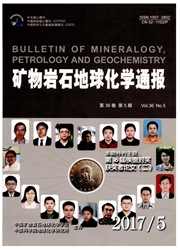

 中文摘要:
中文摘要:
地球科学即研究地球和天体形成和演化的学科,而地质作用的时间是地球科学研究的首要问题。放射性同位素体系定年是地质研究中获得绝对年龄的基本方法,其中U-Pb体系定年是目前固体地球科学年代学研究中应用最广的方法。应用U-Pb体系进行年代学研究,需要考虑几方面的因素,如测试对象是否适宜该体系定年、哪种技术手段更适宜本次研究目的、定年结果的置信度如何、能否在同一分析点上增加其他信息等。本文试图从U-Pb定年体系的原理、特点、技术手段出发,总结如何根据原理选择或判断适宜测试对象、测试方法和对结果的评估等,以期对非同位素地质年代学专业的研究者有所帮助。
 英文摘要:
英文摘要:
The quantification of time is fundamental to investigate the Earth Science,i. e.,deepen our understanding of the planetary evolution and the geological processes. In geological researches,the basic method to acquire an absolute age is the radioactive isotope dating. Recently,the U-Pb dating system is widely used in the solid Earth Sciences. Before performing the U-Pb dating,many aspects should be carefully considered. For example,whether or not the chosen mineral is appropriate for this system,which technical method is suitable for the purpose of the study,how is the confidence level of dating results,can we yield more geochemical information besides dating in the same analytical point,etc. This article summarized principles,characteristics and technical methods of the U-Pb dating system,discussed how to choose or judge the proper minerals and analytical methods and how to evaluate the results. We expect to give helps to the non-professional researchers in the isotopic geochronology.
 同期刊论文项目
同期刊论文项目
 同项目期刊论文
同项目期刊论文
 Generation of early Archaean grey gneisses through melting of older crust in the eastern Kaapvaal cr
Generation of early Archaean grey gneisses through melting of older crust in the eastern Kaapvaal cr NanoSIMS analysis of organic carbon from the Tissint Martian meteorite: Evidence for the past existe
NanoSIMS analysis of organic carbon from the Tissint Martian meteorite: Evidence for the past existe Detrital zircon U-Pb age and Hf isotope constrains on the generation and reworking of Precambrian co
Detrital zircon U-Pb age and Hf isotope constrains on the generation and reworking of Precambrian co NanoSIMS analyses of apatite and melt inclusions in the GRV 020090 Martian meteorite: Hydrogen isoto
NanoSIMS analyses of apatite and melt inclusions in the GRV 020090 Martian meteorite: Hydrogen isoto High-precision simultaneous determination of Sm-147/Nd-144 and Nd-143/Nd-144 ratios in Sm-Nd mixture
High-precision simultaneous determination of Sm-147/Nd-144 and Nd-143/Nd-144 ratios in Sm-Nd mixture Geochronology of the Martian meteorite Zagami revealed by U–Pb ion probe dating of accessory mineral
Geochronology of the Martian meteorite Zagami revealed by U–Pb ion probe dating of accessory mineral Petrogenesis of Jurassic fractionated I-type granites in Southeast China: Constraints from whole-roc
Petrogenesis of Jurassic fractionated I-type granites in Southeast China: Constraints from whole-roc Ar-40/Ar-39 geochronology of the North China and Yangtze Cratons: New constraints on Mesozoic coolin
Ar-40/Ar-39 geochronology of the North China and Yangtze Cratons: New constraints on Mesozoic coolin Rapid cooling of the Yanshan Belt, northern China: Constraints from Ar-40/Ar-39 thermochronology and
Rapid cooling of the Yanshan Belt, northern China: Constraints from Ar-40/Ar-39 thermochronology and Records of the Moon-forming impact and the 470 Ma disruption of the L chondrite parent body in the a
Records of the Moon-forming impact and the 470 Ma disruption of the L chondrite parent body in the a Geochemical transition shown by Cretaceous granitoids in southeastern China: Implications for contin
Geochemical transition shown by Cretaceous granitoids in southeastern China: Implications for contin Re-evaluation of interferences of doubly charged ions of heavy rare earth elements on Sr isotopic an
Re-evaluation of interferences of doubly charged ions of heavy rare earth elements on Sr isotopic an Repeated kimberlite magmatism beneath Yakutia and its relationship to Siberian flood volcanism: Insi
Repeated kimberlite magmatism beneath Yakutia and its relationship to Siberian flood volcanism: Insi Eoarchean ultra-depleted mantle domains inferred from ca. 3.81 Ga Anshan trondhjemitic gneisses, Nor
Eoarchean ultra-depleted mantle domains inferred from ca. 3.81 Ga Anshan trondhjemitic gneisses, Nor In situ simultaneous measurement of Rb-Sr/Sm-Nd or Sm-Nd/Lu-Hf isotopes in natural minerals using la
In situ simultaneous measurement of Rb-Sr/Sm-Nd or Sm-Nd/Lu-Hf isotopes in natural minerals using la NEOPROTEROZOIC S-TYPE GRANITES IN THE ALXA BLOCK, WESTERNMOST NORTH CHINA AND TECTONIC IMPLICATIONS:
NEOPROTEROZOIC S-TYPE GRANITES IN THE ALXA BLOCK, WESTERNMOST NORTH CHINA AND TECTONIC IMPLICATIONS: Zedong terrane revisited: An intra-oceanic arc within Neo-Tethys or a part of the Asian active conti
Zedong terrane revisited: An intra-oceanic arc within Neo-Tethys or a part of the Asian active conti Sintering nano-crystalline calcite: a new method of synthesizing homogeneous reference materials for
Sintering nano-crystalline calcite: a new method of synthesizing homogeneous reference materials for Age determination of nephrite by in-situ SIMS U-Pb dating syngenetic titanite: A case study of the n
Age determination of nephrite by in-situ SIMS U-Pb dating syngenetic titanite: A case study of the n Monazite and xenotime U-Th-Pb geochronology by ion microprobe: dating highly fractionated granites a
Monazite and xenotime U-Th-Pb geochronology by ion microprobe: dating highly fractionated granites a 期刊信息
期刊信息
